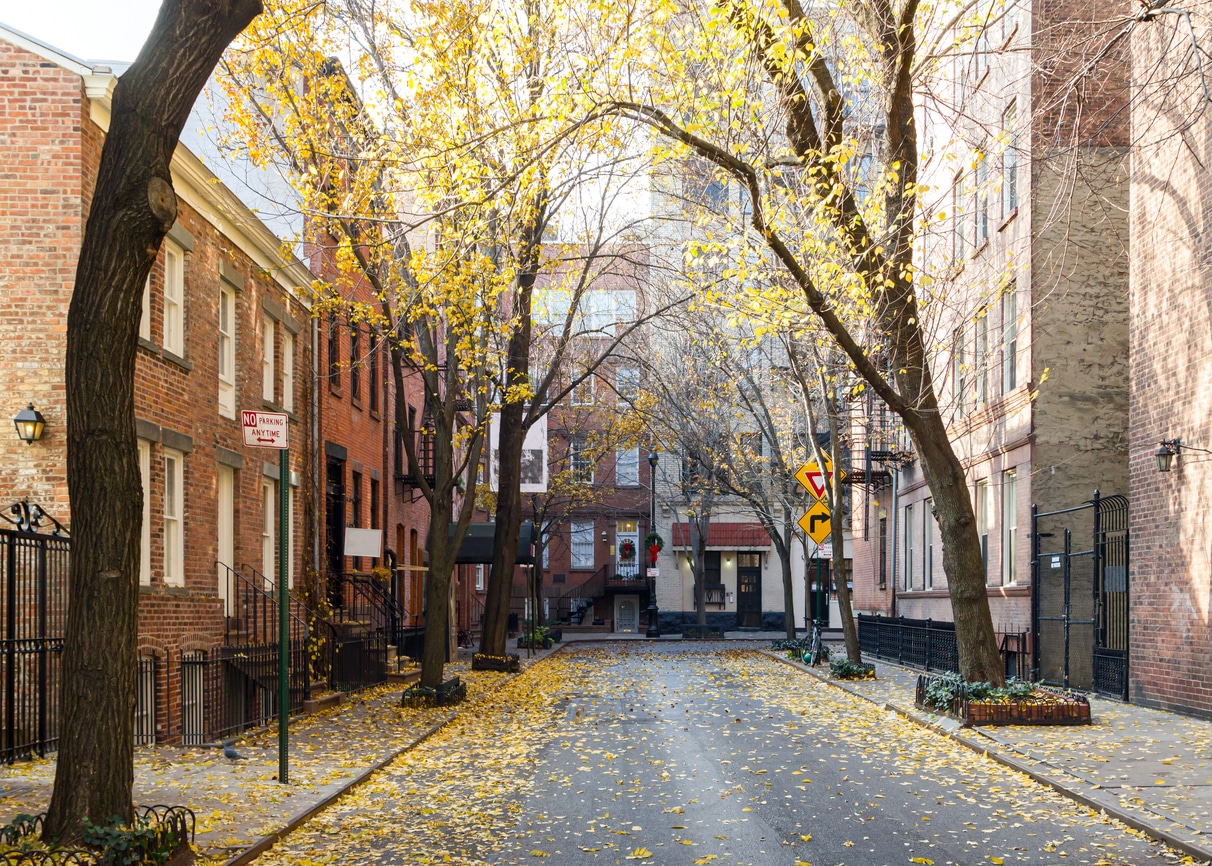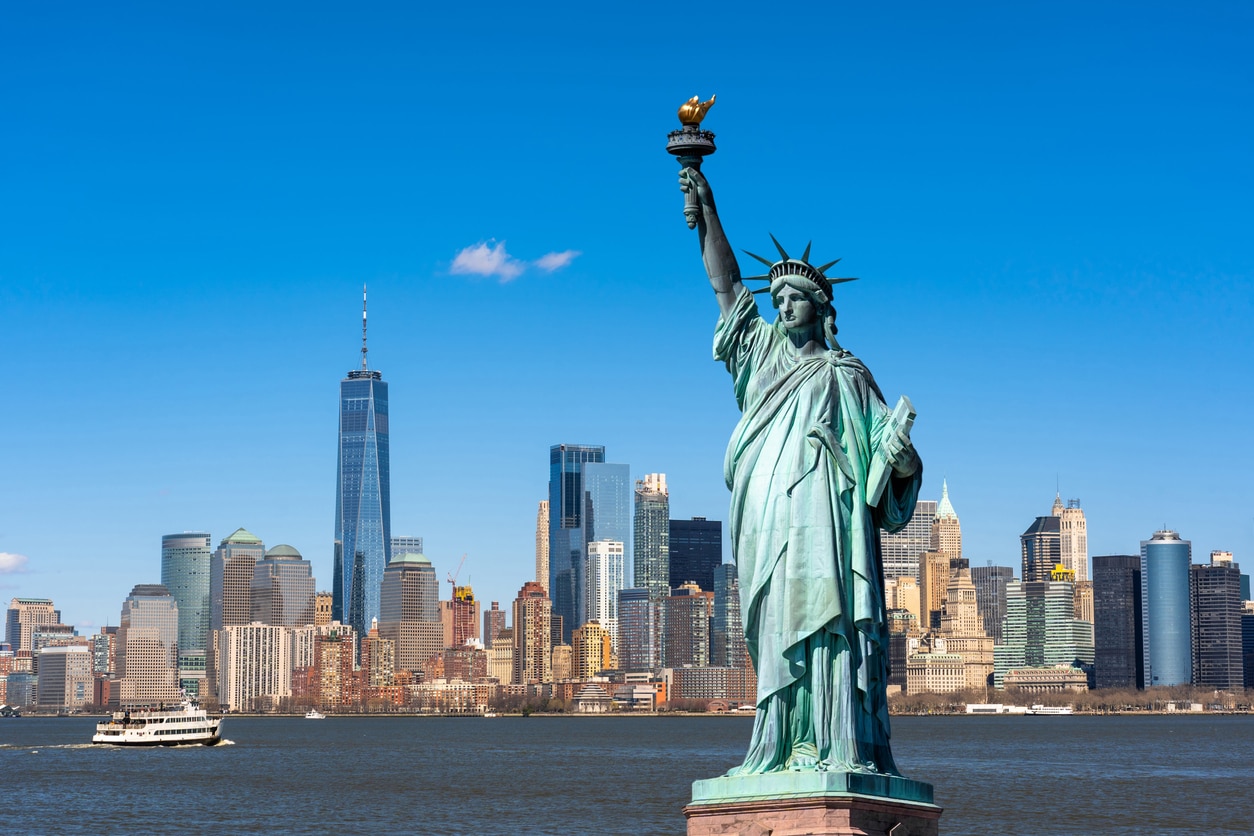In a New York state of mind? The nearly 20 million people who live there are, too.
New York is one of the most populous states in America — and when you see Niagara Falls up close or stand in the middle of Times Square, it isn’t hard to see why.
In New York, you can have it all — from ice skating and Michelin-starred restaurants to sandy beaches and mountain views. Whether you crave the calm of Upstate or the infectious buzz of NYC, living in New York State can be a choose-your-own adventure, almost every day.
While New York was rocked by the pandemic, it’s back and better than ever. Nearly 300,000 people have moved to New York State in the last two years (most of whom hail from New Jersey, California, Pennsylvania, Florida, and Massachusetts). And, according to New York Tourism & Conventions, New York City hosted over 64 million tourists in 2024 alone — back to pre-COVID numbers!
This resurgence is nothing short of remarkable, but times keep changing and may affect how you feel about moving to New York State yourself. That’s why, in this article, we’ll cover what you should know before you go — from the job market and cost of living to unique attractions and the key pros and cons.
Living in New York State: Quick Facts
Population: 19.8 million (2024)
Median Age: 39.6 (2023)
Cost of Living: 26% higher than the national average
Median Income: $42,741
Average Home Value: $485,932
Average Rent (statewide): $2,926/month
New York State Property Tax Rate: 1.64% (almost twice the national average!)
Timeline for Getting a New York ID: 30 Days after moving
Fun Fact: Adirondack Park in Upstate New York is larger than Yellowstone, Yosemite, Grand Canyon, and the Glacier parks combined.

With countless movies, books, and plays set in New York — especially Manhattan — it’s easy to romanticize the idea of moving there — but there are a few realities to reckon with when moving to New York State, too. Here are 7 key things to keep in mind, whether you’re still deciding whether to make the move or you’re getting ready to make your interstate move.
1. Crime in New York State is surprisingly low
New York State ranks #43 for overall crime rates in the country — a pleasantly surprising shift in the last few years. In fact, statewide crime rates have seen a 6% decrease year over year, and eight counties in New York have been recognized among the top 25 safest communities in America.
But of course, New York’s 61 cities aren’t all the safest or most family-friendly. To kickstart your own research, here are a few cities with both the highest and lowest crime rates in the state:
3 safest cities in New York State
3 most dangerous cities in New York State
2. The cost of living in New York State is comparable to California
While crime rates are falling, the cost of living in New York State is, regrettably, skyrocketing.
The overall cost of living in New York State is 26% higher than the national average. While most of that is due to high rent and mortgage rates in NYC, the cost of transportation, utilities, food, healthcare, and other services statewide are also, on average, about 6% higher than the rest of the country.
Even so, New York State isn’t the most expensive state in the U.S. If you’re moving from California to New York, for instance, you could actually save money once you’ve completed your long-distance move, since California’s average cost of living is 12% higher than New York's.
Keep in mind, though, that prices will vary quite a bit city by city. For example, if you were making $100,000 in San Diego and moved to Buffalo, you would only need to make $66,434 in Buffalo to maintain the same standard of living. Conversely, if you made $150,000 in L.A. and relocated to Manhattan — the most expensive city in the nation — you would need to make over $228,000.

Moving to NYC? Check out our New York City moving and neighborhood guides: The Best Brooklyn Neighborhoods |
4. New York State’s housing and rental market is a mixed bag
Overall, the New York State housing market continues to climb — up 8.6% compared to Spring 2024. But just as New York home and rental prices vary greatly city to city — pricing trends are all over the map, too.
As of March 2025, Manhattan is witnessing “record high” rent prices, while home prices, on the other hand, have nosedived. In surrounding neighborhoods like Brooklyn and Queens, as well as Upstate New York, both home and rental prices continue to surge across the board.
The good news is that the average home price in New York statewide is only $485,932, which is significantly cheaper than California’s average home price of $788,920 or Massachusetts’s $635,252. But if you’re hailing from other areas like the Midwest, you should expect to pay more for a home when moving to New York State.
5. New York State’s economy is at an inflection point
New York is dubbed the Empire State for a reason. Known primarily for its status as a global financial powerhouse, a fashion mecca, the media capital of the world, and now, a thriving tech hub — New York State’s economy continues to grow and offer great opportunities across sectors.
That being said, the New York job market hasn’t gone without its challenges in the last few years. The unemployment rate hovered around 4.4% in January, which is slightly higher than the national average. Additionally, while New York has witnessed notable gains in tech, health services, hospitality, and education sectors statewide, it’s seen a dip in trade, transportation, utilities, and finance.
Most concerning of all, though, is the disparity between average income and average expenses of living in New York, particularly in the city. The average salary across New York state is $51,979 a year, or $4,331 a month. If you compare that to the housing and rental rates, the math doesn’t add up.
That’s why the salary you’ll likely need to live in New York State is much higher than the current average income. According to Smart Asset, a single person would need to make $138,570 a year to live comfortably in NYC. For Upstate New York, though, there are more affordable cities to live in, like Syracuse, where you could enjoy living with a much lower salary of around $46,000.
6. You can’t go wrong when choosing where to live in New York State
Every corner of New York offers something special for future residents — but let’s explore some of the best places to put down roots.
New York City: Best for singles and young professionals
New York City is home to over 8 million people, and since 2021, 500,000 college graduates have moved there to start their careers. NYC has always been known for attracting young professionals looking to “make it” in the world while simultaneously enjoying endless entertainment (like Chelsea’s arts district) and 24-hour diners in the city.
Pittsford: Best for families
While NYC boasts several great neighborhoods for raising a family, other towns in Upstate, like Pittsford, are ideal for settling down. Pittsford is the oldest village in New York, set right on the Erie Canal and located just 8 miles outside the bigger city of Rochester. Unlike most of New York, Pittsford has a more affordable cost of living: the median household income in Pittsford is $146,881, while the median home value is just $365,400.
Pittsford is also known for its great public school system, beautiful parks, and beloved restaurants like Richardson’s, which has been serving casual gourmet eats for over a century.
Saratoga Springs: Best for retirees
For retirees, Saratoga Springs offers more low-key, suburban charm — without sacrificing the entertainment larger cities have to offer. Not only does Saratoga Springs have a flourishing live music scene and excellent dining options (make sure to check out Bobby Flay’s favorite fried chicken at Hattie’s), it’s also home to Saratoga Performing Arts Center (SPAC), and the famous horse racing track at Saratoga Casino.

7. There are countless unique things to do in New York State
What isn’t there to do in New York? The list of unique things to do in New York State could truly be endless. But for now, we’re sticking with 10 highlights:
Visit the Statue of Liberty and Ellis Island.
Walk along not one, not two, but 19 waterfalls at Watkins Glen State Park.
Catch a baseball game at Yankee Stadium.
Brave the Catskills Fire Tower Challenge.
Tour Boldt Castle and Boldt Yacht House on Heart Island.
See Wicked or Chicago on Broadway.
Paddle the Saranac River in the Adirondacks in summer.
Ski the slopes at Whiteface Mountain in winter.
Venture to Haunted Hyde Hall in Cooperstown — if you dare.
In short, NY is a great state to move to if you simply can’t stand the idea of being bored. While it may cost you a pretty penny if you choose to live in NYC, living in New York State means you always have adventure, opportunities, and entertainment at every corner.
Living in New York State: Pros & Cons
For millions of people, living in New York lives up to the hype — but it’s not without its drawbacks. Here are the main pros and cons:
Pros of Living in New York State
NYC is a global economic hub with endless opportunities.
You’ll never run out of things to do in New York State.
The scenery in New York — whether you opt for skyscrapers or forests — is breathtaking.
Cons of Living in New York State
The cost of living in New York is exceptionally high compared to the rest of the U.S.
New York income, sales, and property taxes are high.
Winters can be brutal, particularly in Upstate.
Traffic and parking can be nightmarish.
Some cities outside of NYC have aging infrastructure and slower economic growth.
Simplify Your Move to New York State
Whether you dream of a vibrant city life in the most famous hub in America or slow living Upstate, moving to New York State could be just the ticket.
Streamline your move to New York State with the help of Colonial Van Lines. With over 50 years of experience, our trained team of experts has fine-tuned every step of long-distance moving — from packing up your old house to transporting, unloading, and unpacking everything at your new home. Get a free quote today!

